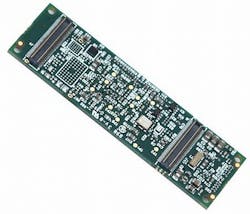Army orders small-form-factor embedded computing from Gumstix on field training instrumentation
TOBYHANNA ARMY DEPOT, Pa., 3 Aug. 2016. U.S. Army training instrumentation experts needed small-form-factorembedded computing modules for a system that evaluates the performance of soldiers during live training. They found their solution from Gumstix Inc. in Portola Valley, Calif.
Officials of the Army Contracting Command at Tobyhanna Army Depot, Pa., announced their intention Monday to buy 2,964 GUM3703E Overo EarthSTORM computer-on-module embedded computers from Gumstix sole-source.
Army Program Executive Office for Simulation, Training, and Instrumentation (PEO STRI) in Orlando, Fla., needs the Gumstix small-form-factor computer modules for the Precision Real-Time Location System (PRTLS) radios and data communications interface (DCI) at the Army Joint Multinational Readiness Center (JMRC) in Hohenfels, Germany.
The Gumstix Overo EarthSTORM embedded computing module measures about three inches long and half an inch wide -- about the size of a stick of gum -- and weighs about a quarter of an ounce. It is based on the ARM Cortex-A8 processor architecture, has 512 megabytes of RAM, and at least 512 megabytes of Flash memory.
The Overo EarthSTORM computer on module is RoHS compliant, operates in temperatures from 0 to 85 degrees Celsius, and uses the 800 MHz Texas Instruments Sitara AM3703 single-core processor. The computer module sells for $109.
Related: PrismTech and Gumstix debut miniature, COTS-based SDR platform
Gumstix is the only responsible source for the embedded computing module, and no other products will satisfy Army requirements, officials say. The Overo EarthSTORM is the only known source for commercial off-the-shelf (COTS) computers on module with 512 megabytes of RAM and 1 gigabyte of onboard NAND flash memory that will function properly when installed into the DCI, Army officials say.
The small physical dimensions and low power consumption of the Gumstix Overo EarthSTORM enable this unit to fit into the small DCI enclosure and to be powered for an extended time by the battery that is supplied to the soldier, Army officials say.
These PRTLS radios are an integral part of the JMRC instrumentation system (JMRC-IS) that collects, processes, displays, and stores training performance data from soldiers performing live, collective training at the JMRC.
The PRTLS radios collect training data from vehicles and foot soldiers and relay that information to the JMRC-IS to monitor the training exercise and provide feedback to the Soldiers in training.
The PRTLS field radio originally was manufactured by Sepura PLC in Waterbeach, England, whose technicians were able to tailor firmware to one of the company's existing products to JMRC PRTLS requirements.
The PRTLS radio for JMRC is a unique device only used at JMRC, which uses a terrestrial trunked radio (TETRA) communications infrastructure that uses only radio technology that complies with German spectrum requirements.
The JMRC TETRA-based radio architecture operates on radio frequencies of 366 to 371 MHz. It must be approved by the JF-12 process of the German National Radio Frequency Office (NARFA), as well as meet Army safety requirements.
Although is not asking for competitive proposals, any company whose officials believe they could provide a product equivalent to the Gumstix Overo EarthSTORM may email the Army's Kristi-Jo Noel no later than 11 Aug. 2016 at [email protected].
More information is online at https://www.fbo.gov/notices/afb14d64080c185fea1c67ceb6c8f272.
For more information contact Gumstix online at www.gumstix.com, or the Army Contracting Command at http://acc.army.mil/contractingcenters/acc-apg.
Learn more: search the Aerospace & Defense Buyer's Guide for companies, new products, press releases, and videos

